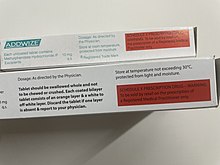Dexmethylphenidate
 | |
 | |
| Clinical data | |
|---|---|
| Trade names | Focalin, Focalin XR, others |
| Other names | d-threo-methylphenidate (D-TMP) |
| AHFS/Drugs.com | Monograph |
| MedlinePlus | a603014 |
| License data | |
| Dependence liability | Physical: None[medical citation needed]; Psychological: High |
| Routes of administration | By mouth |
| ATC code | |
| Legal status | |
| Legal status |
|
| Pharmacokinetic data | |
| Bioavailability | 11–52% |
| Protein binding | 30% |
| Metabolism | Liver |
| Elimination half-life | 4 hours |
| Excretion | Kidney |
| Identifiers | |
| |
JSmol) |
|
| |
| |
| | |
Dexmethylphenidate, sold under the brand name Focalin among others, is a potent
Common side effects include abdominal pain, loss of appetite, and fever.
Dexmethylphenidate was approved for medical use in the United States in 2001.
Medical uses
Dexmethylphenidate is used as a treatment for
Improvements in ADHD symptoms in children were significantly greater for dexmethylphenidate XR versus placebo.
Contraindications
Methylphenidate is
Pregnant women are advised to only use the medication if the benefits outweigh the potential risks.
Adverse effects
Products containing dexmethylphenidate have a side effect profile comparable to those containing methylphenidate.[13]

The most common side effects associated with methylphenidate (in standard and extended-release formulations) are
Smokers with ADHD who take methylphenidate may increase their nicotine dependence, and smoke more often than before they began using methylphenidate, with increased nicotine cravings and an average increase of 1.3 cigarettes per day.[19]
There is some evidence of mild reductions in height with prolonged treatment in children.[20] This has been estimated at 1 centimetre (0.4 in) or less per year during the first three years with a total decrease of 3 centimetres (1.2 in) over 10 years.[21][22]
Methylphenidate can worsen psychosis in people who are psychotic, and in very rare cases it has been associated with the emergence of new psychotic symptoms.[24] It should be used with extreme caution in people with bipolar disorder due to the potential induction of mania or hypomania.[25] There have been very rare reports of suicidal ideation, but some authors claim that evidence does not support a link.[20] Logorrhea is occasionally reported and visual hallucinations are very rarely reported.[17] Priapism is a very rare adverse event that can be potentially serious.[26]
U.S. Food and Drug Administration-commissioned studies in 2011 indicate that in children, young adults, and adults, there is no association between serious adverse
Because some adverse effects may only emerge during chronic use of methylphenidate, a constant watch for adverse effects is recommended.[28]
A 2018
The same review found tentative evidence that it may cause both serious and non-serious adverse effects in children.[29][a]
Overdose
The symptoms of a moderate acute overdose on methylphenidate primarily arise from
A methylphenidate overdose is rarely fatal with appropriate care.[31] Following injection of methylphenidate tablets into an artery, severe toxic reactions involving abscess formation and necrosis have been reported.[32]Treatment of a methylphenidate overdose typically involves the administration of

Addiction and dependence
Methylphenidate is a stimulant with an addiction liability and dependence liability similar to
Biomolecular mechanisms
Methylphenidate has the potential to induce
Interactions
Methylphenidate may inhibit the metabolism of vitamin K anticoagulants, certain anticonvulsants, and some antidepressants (tricyclic antidepressants, and selective serotonin reuptake inhibitors). Concomitant administration may require dose adjustments, possibly assisted by monitoring of plasma drug concentrations.[36] There are several case reports of methylphenidate inducing serotonin syndrome with concomitant administration of antidepressants.[37][38][39][40]
When methylphenidate is coingested with
Coingestion of alcohol (ethanol) also increases the blood plasma levels of d-methylphenidate by up to 40%.[44]
Mode of activity
Methylphenidate is a
Although four
| Compd[51] | DAT (Ki) | DA (IC50) | NET (Ki) | NE (IC50) |
|---|---|---|---|---|
| D-TMP | 161 | 23 | 206 | 39 |
| L-TMP | 2250 | 1600 | >10K | 980 |
| DL-TMP | 121 | 20 | 788 | 51 |
Pharmacology
Dexmethylphenidate has a 4–6 hour duration of effect. A long-acting formulation, Focalin XR, which spans 12 hours is also available and has been shown to be as effective as DL (dextro-, levo-)-TMP (threo-methylphenidate) XR (extended release) (Concerta, Ritalin LA), with flexible dosing and good tolerability.[52][53] It has also been demonstrated to reduce ADHD symptoms in both children[54] and adults.[55] d-MPH has a similar side-effect profile to MPH[13] and can be administered without regard to food intake.[56]
Notes
- ^ "Our findings suggest that methylphenidate may be associated with a number of serious adverse events as well as a large number of non-serious adverse events in children" "Concerning adverse events associated with the treatment, our systematic review of randomised clinical trials (RCTs) demonstrated no increase in serious adverse events, but a high proportion of participants suffered a range of non-serious adverse events."[29]
- ^ The management of amphetamine, dextroamphetamine, and methylphenidate overdose is largely supportive, with a focus on interruption of the sympathomimetic syndrome with judicious use of benzodiazepines. In cases where agitation, delirium, and movement disorders are unresponsive to benzodiazepines, second-line therapies include antipsychotics such as ziprasidone or haloperidol, central alpha-adrenoreceptor agonists such as dexmedetomidine, or propofol. ... However, fatalities are rare with appropriate care.[31]
References
- ^ a b "Focalin- dexmethylphenidate hydrochloride tablet". DailyMed. 24 June 2020. Retrieved 15 November 2020.
- ^ a b "Focalin XR- dexmethylphenidate hydrochloride capsule, extended release". DailyMed. 27 June 2020. Retrieved 15 November 2020.
- ^ a b c d e f g h "Dexmethylphenidate Hydrochloride Monograph for Professionals". Drugs.com. American Society of Health-System Pharmacists. Retrieved 15 April 2019.
- ISBN 9780323187602.
- ^ "Dexmethylphenidate Use During Pregnancy". Drugs.com. Retrieved 15 April 2019.
- ^ S2CID 24975170.
- ^ "The Top 300 of 2021". ClinCalc. Archived from the original on 15 January 2024. Retrieved 14 January 2024.
- ^ "Dexmethylphenidate - Drug Usage Statistics". ClinCalc. Retrieved 14 January 2024.
- ^ a b c "Daytrana- methylphenidate patch". DailyMed. 15 June 2021. Retrieved 26 March 2022.
- ^ "Methylphenidate: Use During Pregnancy and Breastfeeding". Drugs.com. Archived from the original on 2 January 2018.
- PMID 17872810.
- S2CID 3663423.
- ^ S2CID 249894173.
- S2CID 5903121.
- PMID 24074240.
- ^ "Ritalin LA (methylphenidate hydrochloride) extended-release capsules" (PDF). Novartis. Archived from the original (PDF) on 20 July 2011.
- ^ PMID 22654382.)
{{cite journal}}: CS1 maint: DOI inactive as of March 2024 (link - PMID 1363080.
- S2CID 23148548.
- ^ PMID 23294014.
- PMID 16040876.
- PMID 25558298.
- PMID 24532028.
- S2CID 34956456.
- PMID 19015628.
- ^ "Methylphenidate ADHD medications: Drug safety communication – risk of long-lasting erections". U.S. Food and Drug Administration (FDA). 17 December 2013. Archived from the original on 17 December 2013. Retrieved 17 December 2013.
- ^ "FDA drug safety communication: Safety review update of medications used to treat attention-ceficit / hyperactivity disorder (ADHD) in children and young adults". U.S. Food and Drug Administration (FDA). 20 December 2011. Archived from the original on 30 October 2013. Retrieved 4 November 2013.
Cooper WO, Habel LA, Sox CM, Chan KA, Arbogast PG, Cheetham TC, Murray KT, Quinn VP, Stein CM, Callahan ST, Fireman BH, Fish FA, Kirshner HS, O'Duffy A, Connell FA, Ray WA (November 2011). "ADHD drugs and serious cardiovascular events in children and young adults". The New England Journal of Medicine. 365 (20): 1896–1904. PMID 22043968. "FDA Drug Safety Communication: Safety Review Update of Medications used to treat Attention-Deficit/Hyperactivity Disorder (ADHD) in adults". U.S. Food and Drug Administration (FDA). 15 December 2011. Archived from the original on 30 October 2013. Retrieved 4 November 2013. Habel LA, Cooper WO, Sox CM, Chan KA, Fireman BH, Arbogast PG, Cheetham TC, Quinn VP, Dublin S, Boudreau DM, Andrade SE, Pawloski PA, Raebel MA, Smith DH, Achacoso N, Uratsu C, Go AS, Sidney S, Nguyen-Huynh MN, Ray WA, Selby JV (December 2011). "ADHD medications and risk of serious cardiovascular events in young and middle-aged adults". JAMA. 306 (24): 2673–2683.PMID 22161946.
- S2CID 27462347.
- ^ PMID 29744873.
- ^ a b Heedes G, Ailakis J. "Methylphenidate hydrochloride (PIM 344)". INCHEM. International Programme on Chemical Safety. Archived from the original on 23 June 2015. Retrieved 23 June 2015.
- ^ S2CID 40931380.
- PMID 21984207.
- PMID 15014637.
- ^ ISBN 978-0-07-148127-4.
- PMID 16477952.
- ^ "Concerta- methylphenidate hydrochloride tablet, extended release". DailyMed. 1 July 2021. Archived from the original on 26 March 2017. Retrieved 26 March 2022.
- S2CID 5659107.
- S2CID 38523209.
- S2CID 31984813.
- S2CID 35190429.
- S2CID 25026467.
- ^ PMID 10820132.
- PMID 10440465.
- PMID 17339864.
- PMID 9187524.
- ^ PMID 18480678.
- S2CID 28720285.
- S2CID 26046917.
- S2CID 11664668.
- S2CID 8037050.
- S2CID 20232871.
- S2CID 6561452.
- PMID 15662147.
- PMID 15662146.
- S2CID 45976373.
- S2CID 20694072.
